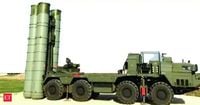In a dramatic escalation of tensions between India and Pakistan, the Indian military successfully thwarted a cross-border missile attack on May 8, 2025, using its advanced S-400 air defense system. This system, also known as the 'Sudarshan Chakra', has been a point of contention due to its origins in Russia and the geopolitical implications surrounding its acquisition.
India currently operates three S-400 systems, with two more set to be delivered by 2026. The system is renowned for its capability to engage multiple aerial threats simultaneously, including aircraft, cruise missiles, and ballistic missiles, at varying ranges and altitudes. It employs a combination of missile launchers, a powerful radar, and a command center, making it one of the most formidable air defense systems in the world.
On the night of May 8, the S-400 system was put to the test when it successfully neutralized 15 missiles launched by Pakistan at Indian military sites. This event underscored the system's effectiveness and the strategic advantage it provides to India amidst ongoing hostilities with its neighbor.
However, this success was met with conflicting reports from Pakistan. On May 10, Pakistani state-run media claimed that its hypersonic missiles, launched from JF-17 fighter jets, had destroyed an Indian S-400 system in Adampur. This assertion was labeled as "false" by an Indian military official, who emphasized that the reports were unfounded and part of a broader narrative being crafted by Pakistan.
Pakistan's claims were echoed by Chinese media, with outlets such as Xinhua and Global Times reporting similar assertions about the destruction of the S-400 system. These reports have drawn skepticism from Indian defense officials, who assert the integrity of their air defense capabilities.
The backdrop to these tensions includes Pakistan's military operation named Bunyan-ul-Marsoos, which was launched in response to what they described as a series of missile strikes from India. The operation commenced on May 10, aiming to counteract perceived threats from Indian military actions, which Pakistan claims have been aggressive and unprovoked.
India's acquisition of the S-400 system has not been without its challenges. The United States had previously expressed concerns over the sale, particularly under the Countering America's Adversaries Through Sanctions Act (CAATSA), which targets nations engaging in significant transactions with Russia. In 2022, however, the U.S. House of Representatives approved an India-specific waiver for the S-400 purchase, allowing India to navigate the complex geopolitical landscape while bolstering its defense capabilities.
High-level sources indicate that the decision to move forward with the S-400 purchase was made firmly in India's national interest. The system's highly advanced radar and interception capabilities were pivotal in the recent confrontation with Pakistan, demonstrating its value in real-time combat scenarios.
As the situation continues to unfold, experts warn that the ongoing conflict between India and Pakistan could escalate into open warfare. The international community is closely monitoring the developments, with calls for de-escalation coming from various quarters, including Turkish President Erdogan, who expressed concern over the rising tensions.
The S-400 air defense system's ability to target aerial threats from distances of up to 600 kilometers makes it a significant asset for India, particularly in the face of Pakistan's continued military operations. The system's design allows it to engage not only traditional aircraft but also modern threats, including cruise and ballistic missiles, which are becoming increasingly sophisticated.
India's strategic investment in the S-400 system, valued at $5 billion under a deal signed in October 2018, reflects a broader trend of nations seeking advanced military technologies to secure their borders against potential aggressors. The implications of this technology extend beyond mere defense; they shape the regional balance of power and influence diplomatic relations.
In conclusion, the use of the S-400 system to thwart Pakistan's missile attack marks a significant moment in the ongoing rivalry between the two nations. As both sides continue to assert their narratives, the potential for miscommunication and escalation remains a pressing concern. The international community's role in mediating these tensions will be critical in the days ahead, as both countries navigate the complex landscape of defense, diplomacy, and national security.





